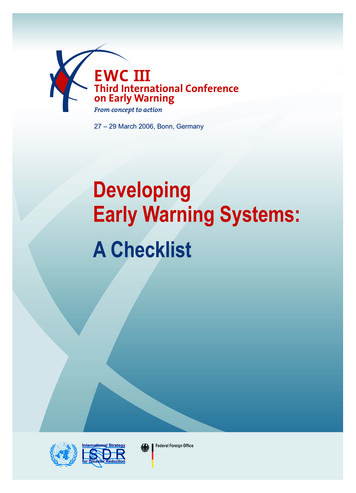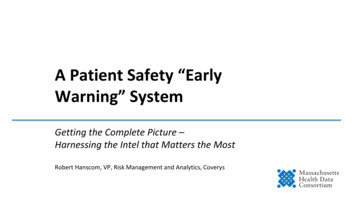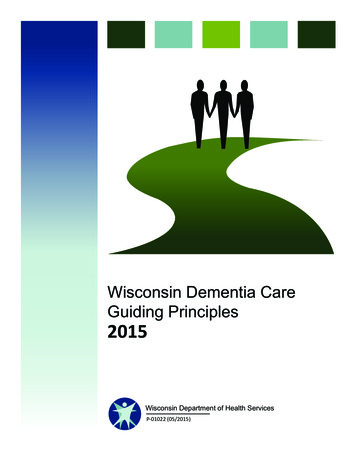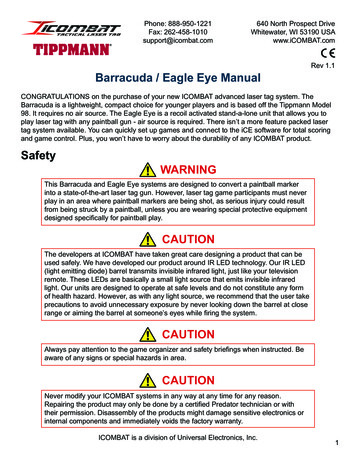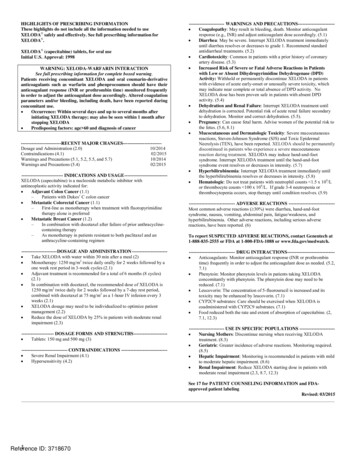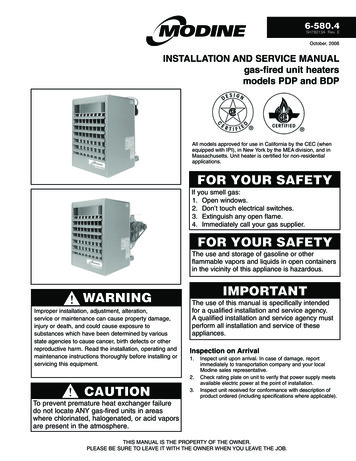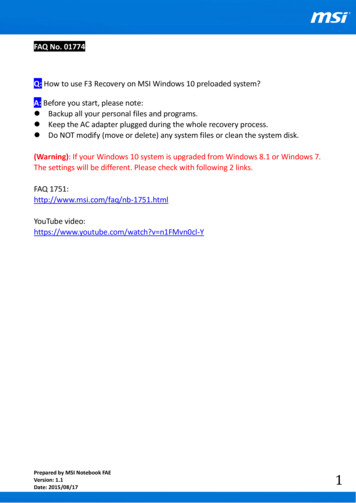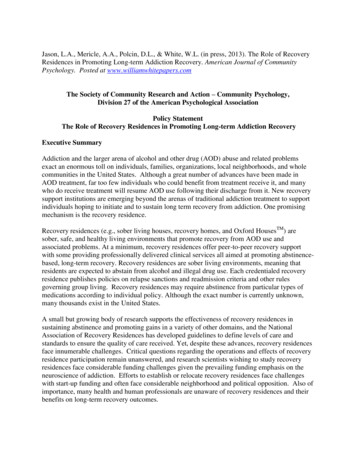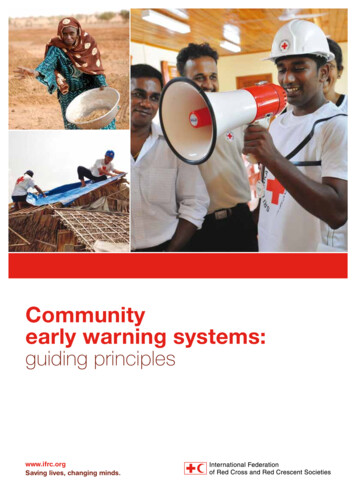
Transcription
Communityearly warning systems:guiding principleswww.ifrc.orgSaving lives, changing minds.
The International Federation of Red Cross and Red Crescent Societies (IFRC) is the world’s largest volunteer-basedhumanitarian network, reaching 150 million people eachyear through our 187 member National Societies. Together, we act before, during and after disasters and healthemergencies to meet the needs and improve the lives ofvulnerable people. We do so with impartiality as to nationality, race, gender, religious beliefs, class and politicalopinions.Guided by Strategy 2020 – our collective plan of action totackle the major humanitarian and development challenges of this decade – we are committed to ‘saving livesand changing minds’.Our strength lies in our volunteer network, our community-based expertise and our independence and neutrality.We work to improve humanitarian standards, as partnersin development and in response to disasters. We persuade decision-makers to act at all times in the interestsof vulnerable people. The result: we enable healthy andsafe communities, reduce vulnerabilities, strengthen resilience and foster a culture of peace around the world. International Federation of Red Crossand Red Crescent Societies, Geneva, 2012Copies of all or part of this study may be made for non-commercialuse, providing the source is acknowledged The IFRC would appreciatereceiving details of its use. Requests for commercial reproductionshould be directed to the IFRC at secretariat@ifrc.org.All photos used in this guidelines are copyright of the IFRC unlessotherwise indicated. Cover photo (from left to right, clockwise): JulieLorenzen/Danish Red Cross; American Red Cross; IFRC.Graphs, courtesy of Leslie Caro Morinière.P.O. Box 372CH-1211 Geneva 19SwitzerlandTelephone: 41 22 730 4222Telefax: 41 22 733 0395E-mail: secretariat@ifrc.orgWeb site: www.ifrc.orgCommunity early warning systems: guiding principles1227800 E 1,500 01/2013
Community earlywarning systems:guiding principlesStrategy 2020 voices the collective determination of theIFRC to move forward in tackling the major challenges thatconfront humanity in the next decade. Informed by theneeds and vulnerabilities of the diverse communities withwhom we work, as well as the basic rights and freedomsto which all are entitled, this strategy seeks to benefit allwho look to Red Cross Red Crescent to help to build amore humane, dignified, and peaceful world.Over the next ten years, the collective focus of the IFRCwill be on achieving the following strategic aims:1. Save lives, protect livelihoods, and strengthenrecovery from disasters and crises2. Enable healthy and safe living3. Promote social inclusion and a cultureof non-violence and peace
International Federation of Red Cross and Red Crescent SocietiesCommunity early warning systems: guiding principlesTable of 7Introduction to community early warning systems: guiding principles91. Background and aims2. Audience: for whom is the guide written?3. Methodology4. OrganizationA. Understanding early warning systems1. Definitions and concepts2. Introduction to the four core early warning system components3. Dispelling early warning myths4. Political and legal international frameworks for early warning5. Institutional frameworks for early warningB. Cross-cutting themes: guiding principlesGuiding principle 1: Integrate within DRR—EWS is not a stand-aloneGuiding principle 2: Aim for synergy across levels: community,national and regional/globalGuiding principle 3: Insist on multi-hazard EWSGuiding principle 4: Systematically include vulnerabilityGuiding principle 5: Design EWS components with multiple functionsGuiding principle 6: Accommodate multiple timescalesGuiding principle 7: Embrace multiple knowledge systemsGuiding principle 8: Account for evolving risk and rising uncertaintyGuiding principle 9: EWS without borders: target the full vulnerability and hazard-scapeGuiding principle 10: Demand appropriate technologyGuiding principle 11: Require redundancy in indicators and communication channelsGuiding principle 12: Target and reach disadvantaged and vulnerable groupsGuiding principle 13: Build partnership and individual 39414345
International Federation of Red Cross and Red Crescent SocietiesCommunity early warning systems: guiding principlesC. Community-level practice: guiding principles per EWS component51Risk knowledgeGuiding principle K-1 Although risk knowledge exercises may not lead to early warning,all early warning must be founded on risk knowledgeGuiding principle K-2 Accept that a community’s priorities may not be your own51MonitoringGuiding principle M-1 Passive receivers of information do not save livesGuiding principle M-2 Some communities will need to DRIVE their EWSGuiding principle M-3 Public displays of monitoring can motivate communitiesGuiding principle M-4 When hazards evolve, so must their monitoring5456585960Response capabilityGuiding principle R-1 In EWS, we respond to warnings, not to disastersGuiding principle R-2 Strive to organize robust no-regrets response actionsGuiding principle R-3 Embed response options in annually updating contingency planswith links to fundingGuiding principle R-4 Practice makes perfect: test-drive your response actions6161636466Warning CommunicationGuiding principle C-1 Clearly delegate responsibility to alert or mediateGuiding principle C-2 Do not fall into the sophistication trap for warning devicesGuiding principle C-3 Use staged warnings (levels and colours) in dissemination676871725353D. Operational Aspects of EWS and CEWS75Annexes79Annex 1: Full list of guiding principlesAnnex 2: List of good practices by zone/country79803
International Federation of Red Cross and Red Crescent SocietiesCommunity early warning systems: guiding principlesAcknowledgmentsCommunity early warning systems: guiding principles is the result of extensiveconsultation and valuable contributions from the National Societies, Red CrossRed Crescent Reference Centres and the International Federation of Red Crossand Red Crescent Societies. In addition, a number of lessons learned and goodpractices were contributed by international and national partners across theglobe; this has enabled the guidelines to reflect a more holistic perspective oncommunity early warning systems. This document benefited greatly from therecommendations provided by the World Meteorological Organization. Theguiding principles were made possible through the financial support receivedfrom the Norwegian Red Cross.4
International Federation of Red Cross and Red Crescent SocietiesCommunity early warning systems: guiding principlesForewordThe decline in human and material losses from disasters over the past 30 years ispartly due to improved early-warning systems, many of them 'high-tech'. Scientificadvances have revolutionized forecasting and the communications technologyused for warnings. The International Federation of the Red Cross and Red CrescentSocieties advocates, however, for a more people-centred approach that is essentialto ensure information and warnings captured by satellites, computer modellingand other technologies reach the most vulnerable communities, who can then acton them. Early warnings alone do not keep hazards from turning into disasters.Early action, covering all time scales, is also essential. It is an investment in thefuture, and has been proven effective at attenuating the effects of disasters.Across the world, significant efforts are being invested in empowering volunteersto take an active role in monitoring risks that influence their communities. Asthey do so, they learn to both issue, and respond to, warnings that arise fromthe monitoring. Where and when national early warning systems are active,these community early warning systems complement governmental mandatesto protect lives and livelihoods. Where they do not yet exist, community earlywarning systems also serve to catalyze dialogue about what national systemsare required and how the National Red Cross and Red Crescent Societies, asauxiliary to governments, may play a role in supporting them.The people-centred approach to early warning, promoted by the HyogoFramework for Action, focuses on how communities must understand threatsin order to avoid them. Disasters are partly caused by external hazards, butthey also stem from vulnerability: people being in the wrong place, at the wrongtime, or without adequate protection or resources to respond to a warning.There is a consensus that communities must, at the very least, be activereceivers of information, while some may even need to be engaged in monitoringso as to facilitate their adoption of protective actions. However, factors asdiverse as knowledge, power, culture, environment, lifestyle and personalityoften determine whether people heed warnings. By engaging communities inthe development of the early warning systems from the beginning many ofthese challenges can be addressed.The present guiding principles of community early warning systems is a livingdocument that launches a process to compile and capitalize on a rich and growingbody of evidence and effort. It gains value by highlighting efforts underway frommore than 50 countries across the world, both inside the International Red Crossand Red Crescent Movement and alongside it, through key partners. It is meantas a starting point from which to catalyze a community of practice in communityearly warning systems. It is our hope that readers will contribute to this dialogue,actively sharing additional examples of good practice and lessons learned.Bekele GeletaSecretary GeneralInternational Federation of Red Crossand Red Crescent Societies5
International Federation of Red Cross and Red Crescent SocietiesCommunity early warning systems: guiding principlesAcronyms6CEWSCommunity early warning systemDREFDisaster Relief Emergency FundDRRDisaster risk reductionEWSEarly warning systemIFRCInternational Federation of Red Cross and Red Crescent SocietiesIGAIncome generating activityNGONon-governmental organizationRATSResponse across time scalesVCAVulnerability and capacity assessment
International Federation of Red Cross and Red Crescent SocietiesCommunity early warning systems: guiding principlesGlossaryDisaster – A serious disruption of the functioning of a community or a societyinvolving widespread human, material, economic or environmental losses andimpacts that exceed the ability of the affected community or society to copeusing its own resources.Disaster risk reduction – The concept and practice of reducing disasterrisks through systematic efforts to analyse and manage the causal factors ofdisasters, including through reduced exposure to hazards, reduced vulnerabilityof people and property, wise management of land and the environment, andimproved preparedness for adverse events.Hazard – A dangerous phenomenon, substance, human activity or conditionthat may cause loss of life, injury or other health impacts, property damage, lossof livelihoods and services, social and economic disruption, or environmentaldamage.Early warning system – The set of capacities needed to generate anddisseminate timely and meaningful warning information to enable individuals,communities and organizations threatened by a hazard to prepare and to actappropriately and in sufficient time to reduce the possibility of harm or loss.Mitigation – The lessening or limitation of the adverse impacts of hazards andrelated disasters.Preparedness – The knowledge and capacities developed by governments,professional response and recovery organizations, communities and individualsto effectively anticipate, respond to, and recover from the impacts of likely,imminent or current hazard events or conditions.Prevention – The outright avoidance of adverse impacts of hazards and relateddisasters.Public awareness – The extent of common knowledge about disaster risks, thefactors that lead to disasters and the actions that can be taken, individually andcollectively, to reduce exposure and vulnerability to hazards.Resilience – The ability of a system, community or society exposed to hazardsto resist, absorb, adapt to and recover from the effects of a hazard in a timelyand efficient manner, including through the preservation and restoration of itsessential basic structures and functions; the positive side of vulnerability.Risk – The probability of an event and its negative consequences.Vulnerability – The characteristics and circumstances of a community, systemor asset that make it susceptible to the damaging effects of a hazard.The definitions in this section are adapted from the UNISDR publicationTerminology of Disaster Risk Reduction.7
International Federation of Red Cross and Red Crescent SocietiesIntroduction to community early warning systems: guiding principlesIntroductionto community earlywarning system:guiding principles1. Background and aimsThe Community early warning systems: guiding principles is one of a set of guidesprepared by the International Federation of Red Cross and Red CrescentSocieties (IFRC), along with the guides for vulnerability and capacity assessment (VCA) and public awareness and public education. It also joins the Disasterresponse and contingency planning guide to provide a solid toolkit for thedisaster risk reduction/management practitioner.In contrast to disaster response mechanisms, early warning is one of many important tools that contribute to the prevention of disasters and preparednessfor hazards and threats, of any kind. It greatly enhances disaster risk reduction(DRR). A well-prepared National Society or non-governmental organization(NGO) will understand and promote the role of people-centred early warningsystems (EWS) in reducing risk. The policy for disaster preparedness highlightsthe role of the IFRC and National Red Cross and Red Crescent Societies i
of people and property, wise management of land and the environment, and improved preparedness for adverse events. Hazard – A dangerous phenomenon, substance, human activity or condition that may cause loss of life, injury or other health impacts, property damage, loss of livelihoods and services, social and economic disruption, or environmental damage. Early warning system – The set of .
